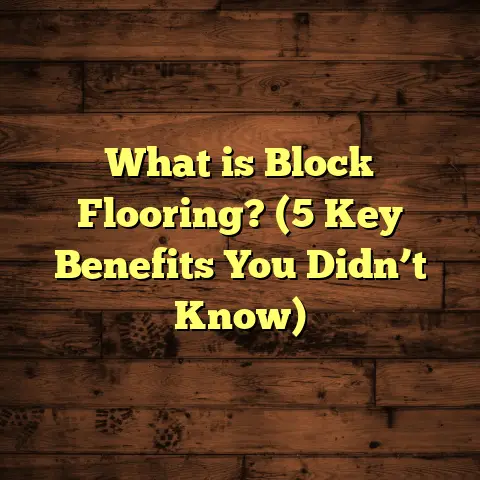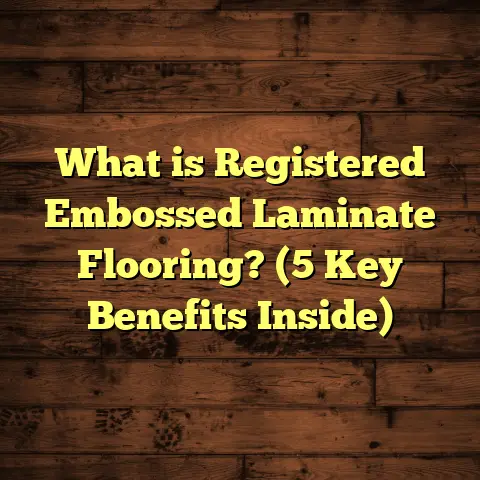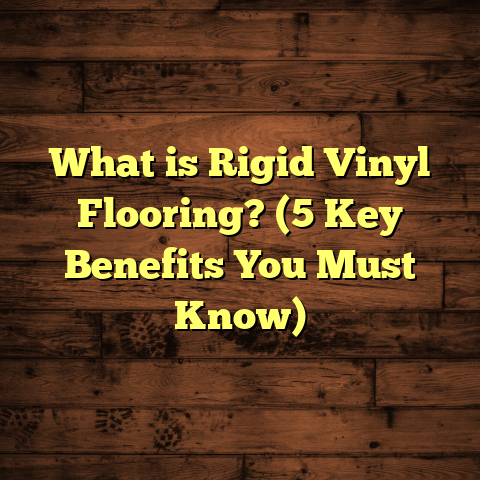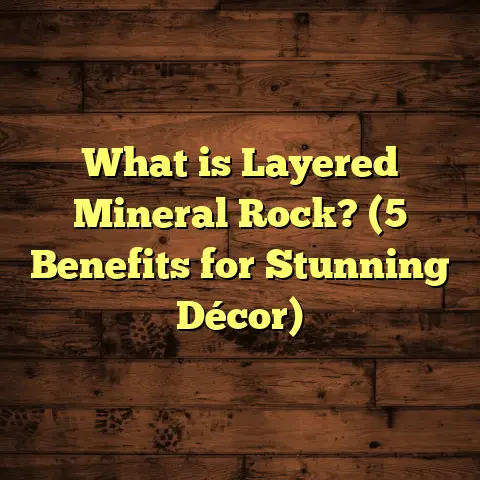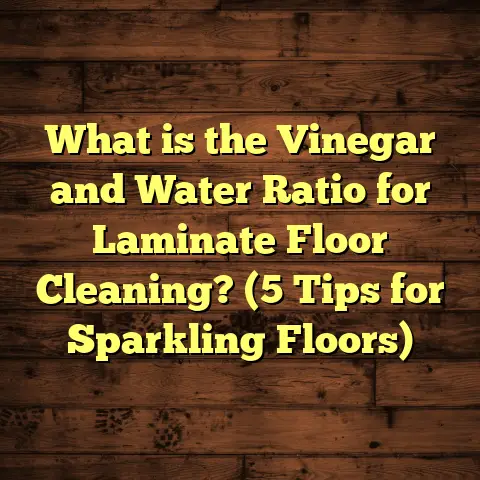What is Vinyl Plank Flooring? (5 Key Tips for the Perfect Choice)
I still remember the first time I walked into a home that had vinyl plank flooring. It was my best friend’s newly renovated place, and the moment I stepped onto that floor, I felt something different. The floor was warm and inviting, yet tough enough that I wasn’t worried about the kids running around or the dog scratching it. I asked my friend what kind of flooring it was. She told me it was vinyl plank, and I admit I was skeptical at first. I thought vinyl was just that cheap, sticky stuff you see in old kitchens or rental apartments. But this was different—elegant, durable, and surprisingly comfortable. That curiosity sparked a journey where I installed vinyl plank floors in several homes, studied the product lines, tested their durability, and even researched the industry trends. I want to share that knowledge with you now so you can make a good choice for your own space.
What Is Vinyl Plank Flooring?
Vinyl plank flooring is a modern type of resilient flooring designed to look like hardwood but made from synthetic materials. Simply put, it’s a floor covering made from layers of PVC vinyl formed into planks that resemble wood boards. Unlike traditional vinyl sheet flooring that comes in large rolls, vinyl plank is manufactured in long, narrow pieces that can be fitted together much like real wood planks.
Breaking Down the Layers
The secret to vinyl plank’s durability and appealing looks lies in its multi-layer construction:
- Wear Layer: This is the topmost layer, usually made of clear polyurethane or aluminum oxide. It protects the floor from scratches, stains, and fading caused by sunlight or heavy foot traffic. The thickness of this layer is one of the main factors determining how long your floor will last.
- Design Layer: Just beneath the wear layer is a printed design layer. This is where manufacturers use high-resolution photography to replicate wood grain, knots, and textures. Some brands even use embossed techniques to create realistic surface textures.
- Core Layer: The core provides structure and stability. There are two common types: rigid core (such as WPC – Wood Plastic Composite or SPC – Stone Plastic Composite) which offers rigidity and impact resistance, and flexible core, which is thinner and more pliable.
- Backing Layer: The bottom layer adds stability and moisture resistance. It can also provide sound insulation.
This construction gives vinyl plank flooring several advantages: it’s waterproof or water-resistant depending on the core type, easy to install, and visually appealing. It’s why many homeowners choose it over hardwood or laminate.
Why Vinyl Plank?
When I chose flooring for my own kitchen renovation, I had a tough decision between hardwood and tile. Hardwood looks amazing but costs a lot and isn’t great around water. Tile is durable but cold and slippery. Vinyl plank offered me a sweet spot: it looked like wood, was warm underfoot, easy to maintain, and handled spills without warping.
Over time, this flooring has continually improved thanks to advances in manufacturing technology. Today’s vinyl planks are much more realistic looking than they were even five years ago. They offer enhanced durability and come in a variety of styles suitable for any room.
A Brief History of Vinyl Flooring
Vinyl flooring has been around since the 1930s but became widely popular in residential use after World War II. Early forms were made from polyvinyl chloride (PVC) sheets in solid colors or simple patterns. These floors were affordable but not visually impressive.
Vinyl plank flooring as we know it started gaining traction in the early 2000s with improvements in printing technology and layering techniques. This allowed manufacturers to recreate the look of natural wood with great accuracy.
The introduction of rigid core vinyl planks further expanded its appeal by combining the realism of hardwood with superior durability and waterproof qualities. Today, vinyl plank floors represent nearly 30% of all residential flooring sales in the U.S., according to data from the National Wood Flooring Association (NWFA).
The Anatomy of Vinyl Plank Flooring: More Details
Let me dig deeper into each component of vinyl plank so you can understand why each part matters.
Wear Layer Thickness
The wear layer is measured in mils (thousandths of an inch). Common thicknesses are:
- 6 mil: Basic protection; suitable for bedrooms or low-traffic areas.
- 12 mil: Standard residential use with moderate durability.
- 20 mil or more: Commercial-grade floors with excellent protection against scratches and dents.
The thicker this layer is, the longer your floor will resist wear. In my experience installing floors in busy homes with pets and kids, I always recommend at least 12 mil for residential use.
Design Layer: Realism and Texture
High-resolution printing technology allows manufacturers to replicate wood grain so convincingly that even experts sometimes need to look twice.
Embossing adds texture to the surface so you can feel wood grain patterns beneath your feet. Some premium planks offer hand-scraped or distressed finishes that add character.
From oak to hickory to exotic woods like Brazilian cherry, you have an extensive palette of colors and patterns available.
Core Types: SPC vs WPC vs Flexible Vinyl
- SPC (Stone Plastic Composite): Made with limestone mixed into PVC for added density. SPC is very rigid, highly durable, and waterproof. It feels solid underfoot but can be colder than other options.
- WPC (Wood Plastic Composite): Incorporates wood pulp or fibers for a slightly softer feel compared to SPC. WPC is also waterproof but tends to have a bit more “give,” which some find more comfortable standing on for long periods.
- Flexible Core Vinyl: Thinner and more pliable; often less expensive but less durable and more prone to indentations.
For areas like kitchens or basements where moisture is a concern, SPC or WPC rigid cores are best.
Backing Layer
The backing adds stability and sometimes includes soundproofing materials like cork or foam pads attached beneath the plank.
A good backing layer helps reduce noise when walking on the floor and prevents moisture from seeping up from below.
How Vinyl Plank Compares to Other Flooring Types
Let me share some comparisons based on my own installations over the years.
| Flooring Type | Cost per sq.ft | Water Resistance | Durability | Maintenance | Installation |
|---|---|---|---|---|---|
| Vinyl Plank | $2 – $7 | Waterproof | High | Easy | Floating / Glue |
| Hardwood | $6 – $12 | Low | Moderate | Requires refinishing | Nail-down / Glue |
| Laminate | $1.50 – $4 | Water-resistant | Moderate | Easy | Floating |
| Tile (Ceramic/Porcelain) | $3 – $10 | Waterproof | Very High | Moderate | Mortar/Grout |
| Carpet | $2 – $8 | Not waterproof | Low | High | Staple / Glue |
Vinyl plank strikes a balance between cost-effectiveness, durability, and water resistance that makes it popular for kitchens, bathrooms, basements, even living rooms.
5 Key Tips for Choosing Your Vinyl Plank Flooring
Here are some tips drawn from my years on the job to help you make a perfect choice.
1. Decide What Type Fits Your Needs Best
Are you looking for high durability? Consider SPC rigid core with a thick wear layer (20+ mil). For comfort underfoot, WPC might be better.
Don’t skimp on quality in high-traffic areas; cheaper flexible vinyl can dent easily.
2. Pay Attention to Wear Layer Thickness
This is crucial for longevity. Homes with kids or pets should go for 12 mil wear layers at minimum; commercial spaces require even more robust options.
I once installed a low-wear layer floor in a busy entryway that started showing scratches within months—lesson learned!
3. Think About Installation Method
If you’re a DIY fan, floating click-lock planks are your best bet—they snap together without glue or nails.
Glue-down planks offer enhanced stability but require skill and time to install properly.
Also think about your subfloor type—concrete slabs might need different prep than plywood.
4. Style Matters
Pick colors and textures that complement your space but also hide dirt well if you want less cleaning hassle.
Textured finishes do better at disguising scratches than smooth ones.
For example, distressed oak patterns work well in rustic kitchens; sleek gray planks look great in modern homes.
5. Factor in Warranty and Brand Reputation
Not all vinyl planks are created equal—check warranty terms carefully (some go up to 30 years).
Look for brands with strong customer reviews and proven track records.
What About Cost? Breaking Down Budget Expectations
Budgeting for vinyl plank involves more than just material price:
- Material costs: Usually between $2 to $7 per square foot depending on quality.
- Installation: Professional installers charge $1.50 to $4 per square foot on average.
- Subfloor preparation: Sometimes additional cost if leveling or repairs are needed.
- Accessories: Underlayment (if needed), moldings, transition strips.
In one project for a mid-sized kitchen (~200 sq.ft), I spent about $1,800 total for mid-range LVP with professional installation—way less than hardwood options that started around $4,000 for similar areas.
Installation Insights From Personal Projects
From my experience installing floors myself and for clients:
- Always check subfloor for moisture issues before installation.
- Make sure planks acclimate in your home for at least 48 hours before starting.
- Follow manufacturer instructions closely—different brands have different locking systems.
- Use spacers around edges to allow expansion.
- Clean subfloor thoroughly before laying down planks.
One memorable installation was a basement remodel where we used SPC rigid core planks over an existing concrete slab with radiant heat tubing embedded below—a perfect combo for warmth and waterproofing.
How Durable Is Vinyl Plank Flooring Really?
Durability depends on several factors:
- Quality of wear layer
- Core composition
- Subfloor preparation
- Traffic levels
- Maintenance habits
In my work with families who have pets or kids, vinyl plank has performed exceptionally well—resisting scratches from claws and dents from dropped items better than laminate or hardwood.
A study from FloorScore reported that modern vinyl plank floors can last 15–20 years under normal residential use when well maintained.
Waterproofing: A Game Changer for Wet Areas
One thing that sold me on vinyl plank was its resistance to water damage.
Traditional hardwood swells or warps when exposed to moisture; laminate can delaminate; carpet traps mold risks.
With waterproof cores like SPC/WPC combined with tight locking systems and sealed edges, spills or even flooding won’t ruin your floor easily.
I’ve installed these floors in bathrooms and basements where humidity levels fluctuate—and they’ve held up beautifully without warping or staining.
Design Trends: What’s Hot in Vinyl Plank Flooring?
Styles evolve quickly:
- Wide Planks: Wider boards create a more modern look; often 7” to 9” wide.
- Mixed Widths: Some brands sell mixed widths for a more natural appearance.
- Matte Finishes: Less shine means floors look more authentic.
- Hand-Scraped & Distressed Looks: Adds character; great for vintage or farmhouse styles.
- Gray & Cool Tones: Popular choice for contemporary interiors.
I helped a client pick wide matte oak-look planks for their open-concept loft—the result felt airy yet cozy.
Environmental Impact & Sustainability
You might wonder if vinyl plank flooring is eco-friendly. Historically, PVC production raised environmental concerns because of chemicals used during manufacturing.
But there’s progress: many manufacturers now produce low-VOC (volatile organic compounds) vinyl planks certified by FloorScore or GREENGUARD programs ensuring better indoor air quality.
Some brands incorporate recycled content without sacrificing quality.
If sustainability matters to you, look for certifications when choosing products.
Real-Life Case Study: Vinyl Plank Flooring in Rental Properties
I once worked with a property manager who needed durable flooring for several rental units prone to wear-and-tear from tenants moving furniture frequently.
We chose SPC rigid core LVP with 20 mil wear layers for all units:
- Result: Over two years, minimal complaints about damage.
- Tenants appreciated easy cleaning compared to carpet.
- Landlord saved money on repairs compared to previous hardwood floors damaged by water leaks.
This project highlighted how vinyl plank can be both stylish and practical for commercial/residential hybrids like rentals.
Maintenance Made Simple: My Best Tips
Keeping vinyl plank floors looking great requires minimal effort:
- Sweep or vacuum regularly using soft-bristle attachments.
- Mop occasionally with damp microfiber mop using mild cleaners formulated for vinyl.
- Avoid abrasive scrubbers or harsh chemicals like bleach.
- Use felt pads under furniture legs.
- Clean spills immediately.
I’ve seen floors stay pristine after years just by following these simple steps.
Common Myths About Vinyl Plank Flooring Debunked
There’s some outdated thinking floating around:
- Myth: Vinyl looks cheap or fake. — Today’s designs are almost indistinguishable from real wood.
- Myth: It wears out quickly. — High-quality planks last 15+ years in most homes.
- Myth: It’s hard to install. — Many products feature click-lock systems perfect for DIYers.
- Myth: It’s bad for indoor air quality. — Many products meet strict low-VOC certifications.
Knowing these facts helped me convince many clients hesitant at first about vinyl plank flooring.
How To Pick The Right Brand
Brand matters because manufacturing quality varies widely:
Look for:
- Clear warranty terms (ideally 20+ years residential)
- Positive customer reviews
- Good customer support
- Low VOC certifications
- Availability of replacement pieces
Some trusted brands I’ve worked with include Shaw Floorte, COREtec, Armstrong Vivero, and Mohawk SolidTech.
Personal Reflections: Why I Recommend Vinyl Plank Flooring
Having installed many types of floors over my career—hardwood, laminate, tile—I keep coming back to vinyl plank as one of my favorite solutions because:
- It blends beauty with functionality effortlessly.
- It stands up well to daily life chaos without demanding special care.
- It offers excellent value compared to hardwood or tile.
- Modern styles suit nearly any home decor style.
In short: it balances looks, durability, ease of care, and affordability better than most alternatives I’ve seen.
If you’re thinking about updating your floors soon or just curious about what vinyl plank could do for your home, feel free to ask me anything about brands, installation tips, maintenance hacks—I’m here to help!
